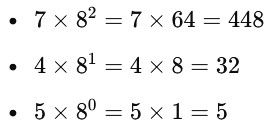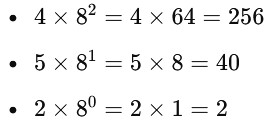
Octal to Decimal
The octal to decimal converter helps you change an octal number (base-8) to a decimal number (base-10), for numbers up to 63 digits long. It also provides a table to convert binary numbers to decimal numbers.
In the world of computing and mathematics, different numeral systems play pivotal roles. Among these, the octal (base-8) and decimal (base-10) systems are commonly used. Converting numbers between these systems is a fundamental skill, particularly for programmers and computer scientists. In this comprehensive guide, we'll delve into the intricacies of octal to decimal conversion, exploring the concepts, methods, and practical applications.
What is the Octal System?
The octal system, also known as base-8, is a numeral system that uses eight distinct digits: 0, 1, 2, 3, 4, 5, 6, and 7. This system is particularly useful in computing, as it provides a more compact representation of binary-coded data. Historically, the octal system was widely used in digital systems, especially those involving early computers and Unix-based systems.
How Does the Octal System Work?
Each position in an octal number represents a power of 8, starting from 8^0 (the units place) at the rightmost digit. For example, the octal number 745 represents:
![]()
Breaking it down:

Adding these values together gives the decimal equivalent:
448+32+5=485
Thus, the octal number 745 converts to 485 in decimal.
What is the Decimal System?
The decimal system, or base-10, is the most commonly used numeral system worldwide. It uses ten digits: 0, 1, 2, 3, 4, 5, 6, 7, 8, and 9. Each position in a decimal number represents a power of 10, making it intuitive and easy to use for everyday counting and arithmetic operations.
How Does the Decimal System Work?
Each position in a decimal number represents a power of 10. For example, the decimal number 345 represents:
![]()
Breaking it down:

Adding these values together gives:
300+40+5
Why Convert Octal to Decimal?
There are several reasons why converting octal numbers to decimal is essential:
- Human Readability: Decimal is the standard numeral system used in daily life, making it easier for humans to read and understand.
- Interfacing with Systems: Many computer systems, particularly older ones, utilize octal representations. Converting these to decimal helps in debugging and interfacing with modern systems.
- Mathematical Operations: Performing arithmetic operations is generally more straightforward in the decimal system, as it aligns with our conventional counting methods.
Methods for Octal to Decimal Conversion
Converting octal numbers to decimal can be done manually or using automated tools. Let's explore both approaches.
Manual Conversion Method
Converting an octal number to decimal manually involves understanding the place values and summing the appropriate powers of 8. Here’s a step-by-step guide:
- Write down the octal number: For example, 452.
- Identify the place values: From right to left, the places are 8^0, 8^1, and 8^2.
- Multiply each digit by its corresponding power of 8:

- Sum the results: 256+40+2=298
Thus, the octal number 452 converts to 298 in decimal.
Using an Octal to Decimal Converter
For quick and accurate conversions, an octal to decimal converter tool can be incredibly useful. These tools automate the process, ensuring error-free results. Here’s how to use an online octal to decimal converter:
- Input the Octal Number: Enter the octal number into the designated field.
- Initiate Conversion: Click the "Convert" or similar button.
- View the Result: The tool will display the decimal equivalent of the entered octal number.
Such tools are widely available online and can handle complex conversions instantaneously.
Practical Applications of Octal to Decimal Conversion
Understanding and utilizing octal to decimal conversion is crucial in various fields, particularly in computing and electronics. Here are some practical applications:
Computing and Programming
In programming, especially in low-level languages like assembly, octal numbers are often used to represent binary data compactly. Converting these numbers to decimal can help programmers understand and debug code more efficiently.
Digital Electronics
Octal numbers are used in digital electronics to simplify the representation of binary sequences. Engineers often convert these octal values to decimal to analyze and design circuits.
Historical Systems
Older computer systems, including early Unix systems, utilized octal numbering extensively. Understanding these systems requires converting octal numbers to decimal to interpret system configurations and permissions accurately.
Advantages of Using Octal System
While the decimal system is more intuitive for human use, the octal system has distinct advantages in computing:
- Compact Representation: Octal provides a more compact representation of binary data, reducing the length of binary sequences by grouping bits.
- Ease of Conversion: Octal is simpler to convert to and from binary compared to hexadecimal (base-16), making it easier for certain low-level operations.
- Legacy Systems Compatibility: Many legacy systems and protocols still use octal, making it essential for compatibility and maintenance.
Challenges in Octal to Decimal Conversion
Despite its advantages, converting octal to decimal can pose challenges:
- Manual Errors: Manual conversion is prone to errors, especially with larger numbers.
- Misinterpretation: Misinterpreting place values can lead to incorrect results, particularly for those unfamiliar with the octal system.
- Tool Dependency: Over-reliance on automated tools may hinder understanding of the underlying principles.
Best Practices for Accurate Conversion
To ensure accurate octal to decimal conversion, consider the following best practices:
- Double-Check Manual Calculations: When converting manually, double-check each step to avoid errors.
- Use Reliable Tools: Utilize reputable octal to decimal converter tools for quick and accurate conversions.
- Understand the Concepts: Familiarize yourself with the principles behind the octal and decimal systems to enhance your understanding and accuracy.
- Practice Regularly: Regular practice with different octal numbers can help solidify your conversion skills.
Conclusion
Converting octal to decimal is a fundamental skill in computing and digital electronics. Understanding the principles behind the octal and decimal systems, along with the methods for conversion, is crucial for programmers, engineers, and anyone dealing with numeral systems. Whether you choose to convert manually or use automated tools, mastering this conversion will enhance your ability to work with various numeral systems efficiently. By following best practices and utilizing reliable tools, you can ensure accurate and effective octal to decimal conversions, making your work in computing and electronics more efficient and error-free.

Azahar Ahmed
CEO / Co-Founder
I am Azahar Ahmed, a youthful Engineer, Entrepreneur, Digital Marketer, and Motivational speaker native to Nagaon, Assam, India. Originating from a middle-class background, I am the sole son. My accomplishments are indebted to my father, a Teacher, and my mother, formerly a Teacher but now devoted to our well-being. My mother has been my closest ally, and unitedly, my parents have fostered and realized all my aspirations, epitomizing the perfect parents.







